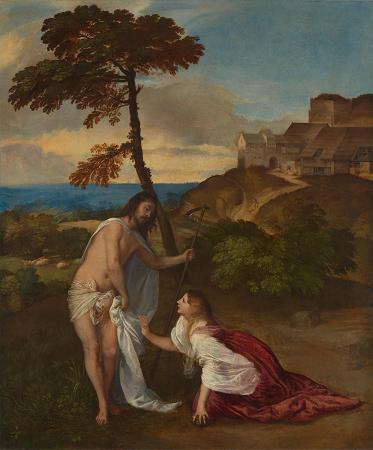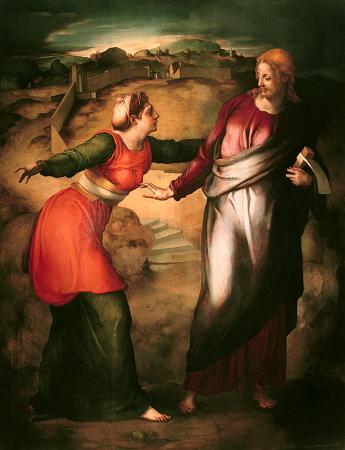Noli Me Tangere. Noli me tangere is the Latin version of a phrase spoken, according to John 20:17, by Jesus to Mary Magdalene when she recognized him after his resurrection. The biblical scene gave birth to a long series of depictions in Christian art from Late Antiquity to the present. The original Koine Greek phrase, is better represented in translation as cease holding on to me or stop clinging to me, i.e. an ongoing action, not one done in a singlemoment. According to Maurice Zundel, in asking Mary Magdalene not to touch him, Jesus indicates that once the resurrection is accomplished, the link between human beings and his person must no longer be physical, but must be a bond of heart to heart. He must establish this gap, she must understand that the only possible way is faith, that the hands can not reach the person and that it is from within, from within only, that the we can approach Him. Likewise, later, when Thomas reached out to touch the wounds of Jesus, he declares: blessed are those who have not seen and yet have believed because He knows it is useless. The words are a popular trope in Gregorian chant. The supposed moment in which they were spoken was a popular subject for paintings in cycles of the Life of Christ and as single subjects, for which the phrase is the usual title. In the Eastern Orthodox Church, the Gospel lesson on Noli me tangere is one of the Twelve Matins Gospels read during the All Night Vigil on Sunday mornings. In medicine, the words were occasionally used to describe a disease known to medieval physicians as a hidden cancer or cancer absconditus, as the more the swellings associated with these cancers were handled, the worse they became. The phrase or a paraphrase in the vernacular is often drilled into surgical students regarding organs of the body that are notoriously delicate or prone to develop complications if disturbed; up through the early half of the 20th century, the most common invocation of this phrase concerned the heart. In current times, the organ considered most deserving of the phrase is typically the pancreas; the maxim eat when you can, sleep when you can, don't mess with the pancreas is commonly found in surgical anecdotes. The expression found its way into culture and literature. Following Petrarch, in the lyric poem Whoso list to hunt the 16th-century poet Sir Thomas Wyatt, mentions a hind who stands for the elusive lover hunted by the speaker, with an inscribed collar: There is written, her fair neck round about: / Noli me tangere, for Caesar's I am. The idea probably originates in a story of Pliny the Elder about deer of Caesar, which lived 300 years and had collars with the inscription, perhaps related to one of Solinus about Alexander the Great collaring deer, who then survive 100 years, though no inscription on the collars is mentioned. The phrase was also used as the title for Jose Rizal's book criticizing the Spanish colonization of the Philippines. The phrase evokes a cancer of the eyelids, for which ophthalmologists used the phrase; it symbolizes the people's blindness to the ruling government, which Rizal deemed the social cancer that people were too afraid to touch. Historically, the phrase was used by Revolutionary-Era Americans in reference to the Gadsden flag, with its derivation don't tread on me, and other representations dating to the American War for Independence. In the United States military, the phrase is the motto of the US Army's oldest infantry regiment, the 3rd U.S. Infantry Regiment, located at Fort Myer, Virginia; the snake symbol can be found in the coat of arms of the 369th Infantry Regiment, known as the Harlem Hellfighters. Don't tread on me is also the motto of No. 103 Squadron, Royal Air Force. The biblical scene of Mary Magdalene's recognizing Jesus Christ after his resurrection became the subject of a long, widespread and continuous iconographic tradition in Christian art from Late Antiquity until today. Pablo Picasso, for example, used the painting Noli me tangere by Antonio da Correggio, stored in the Museo del Prado, as an iconographic source for his painting La Vie from the so-called Blue Period.
more...













